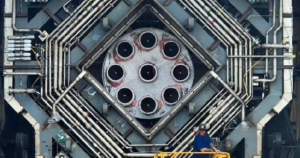
The End of Helicopter Catch Attempts, Upcoming Launch, & More
Rocket Lab has been working on Electron reusability for years now. Starting around 2020 the company began attempting to recover the first stage with controlled water landings. After promising results they moved toward an even more ambitious goal, catching the falling first stages out of mid air with a helicopter. However, in the few recovery attempts using this method, the results have not been the most promising.
Just days ago during Rocket Lab’s earnings call, Peter Beck said the company was deciding whether or not this process was worth it going forward. This comes in addition to a successful wet dress rehearsal the was recently completed. Not to mention Rocket Lab also established a new wholly-owned subsidiary, Rocket Lab Australia, to explore opportunities to support the expansion of Australia’s national space capabilities.
Right now the company is trying to grow and become a one stop shop within the industry. They know that reusability is an important aspect and are looking at other opportunities for Electron’s booster. Here I will go more in-depth into the new plans regarding recovery, the upcoming launch of Electron, the new Australia subsidiary, and more.
Recovery Changes

On February 28th, Rocket Lab held an earnings call which included a few comments from CEO Peter Beck. He first said that the company was weighing recovering stages from the ocean and refurbishing them for launch rather than catching a stage with a helicopter.
Starting in May of last year, launched from Pad A at Rocket Lab Launch Complex 1 on New Zealand’s Mahia Peninsula, the “There And Back Again” marked the company’s 26th Electron launch. This mission was a recovery mission where, for the first time, Rocket Lab attempted to catch Electron’s first stage as it returned from space under parachutes using a helicopter. After launching to space, Electron’s first stage returned to Earth under a parachute. At 6,500 ft, Rocket Lab’s Sikorsky S-92 helicopter rendezvoused with the returning stage and used a hook on a long line to capture the parachute line. However, soon after the catch, Rocket Lab reported that the helicopter pilot detected different load characteristics than previously experienced in testing and offloaded the stage for a successful splashdown. The stage was then loaded onto Rocket Lab’s recovery vessel for transport back to the Company’s production complex for analysis and assessment for re-flight as planned.
Finally, we have the most recent attempt only months ago during the Catch Me If You Can mission. Similar to the previous attempt, the goal was to catch Electron’s booster out of mid air using a helicopter. In this case, the company was once again unsuccessful. Specifically, Rocket Lab reported that they had planned to attempt a mid-air capture of Electron’s first stage with a helicopter if conditions allowed. In regard to this most recent failed attempt, Peter Beck commented during the recent call that “This turned out to be quite a happy turn of events. Electron survived an ocean recovery in remarkably good condition, and in a lot of cases its components actually pass requalification for flight.”
The company is planning an ocean recovery on an upcoming flight after incorporating additional waterproofing into the vehicle. In another quote, Peter Beck said, “Pending this outcome of testing and analysis of the stage, the mission may move us towards sticking with marine recovery altogether and introduce significant savings to the whole operation. In 2022 we proved that it was possible to rendezvous with a returning stage mid-air and get it on the helicopter hook, but if we can save ourselves the extra step by just plucking out in water we will. What the water landing does enable us to do is recover more vehicles because we don’t have the constraints of the operations of the helicopter,” he said. “So, financially it’s kind of the same, but we get to actually reuse more vehicles.”
Just yesterday the company tweeted saying, “Say it with us – red is for recovery! Once Electron has launched @BlackSky_Inc’s spacecraft from LC-1 later this month, the first stage is coming back to Earth under a parachute and splashing down for a marine recovery.” Rocket Lab is already putting this new theory to the test on a launch later this month. What’s exciting is that they are preparing to launch two dedicated missions in March from the Company’s launch sites in the United States and New Zealand – within days of each other.
One Electron rocket is ready and in position at Rocket Lab Launch Complex 1 in New Zealand to deploy satellites for Spaceflight Inc. customer BlackSky (NYSE: BKSY), a real-time geospatial intelligence company. Meanwhile, a second rocket is simultaneously undergoing final launch preparations at Launch Complex 2 in Virginia to deploy satellites for American space tech company Capella Space, the world’s leading provider of commercial Synthetic Aperture Radar (SAR) imagery.
Australia Subsidiary

Now that we know more about Rocket Lab’s updated recovery plans and its upcoming missions, we can take a closer look at the company’s new plans in Australia. On February 28th, Rocket Lab tweeted mentioning, “G’day mate, Introducing Rocket Lab Australia. We’re exploring how our rockets, satellites, and space tech can support and strengthen Australia’s position in the global space sector.”
Specifically, they announced that they have established a new wholly-owned subsidiary, Rocket Lab Australia, to explore opportunities to support the expansion of Australia’s national space capabilities. The Australian Government has set a goal to triple the size of the Australian space sector from an estimated AUD$4 billion in 2016 to AUD$12 billion and create an additional 20,000 jobs by 2030. To help facilitate this growth, the Australian Government has committed more than AUD$2 billion to the civil space sector since 2018 for programs spanning Earth Observation, satellite infrastructure, high-tech manufacturing, and support for NASA’s Moon to Mars Artemis Program.
The Australian Government has also committed AUD$17 billion above and beyond this civil space investment for the development of Defence space capabilities as part of the 2020 Force Structure Plan to maintain and upgrade existing space capabilities, as well develop new capabilities to solve problems domestically and service global partners. The Five Eyes intelligence alliance between Australia, Canada, New Zealand, the United States, and the United Kingdom is one such example of Australia’s global partnerships. With the establishment of Rocket Lab Australia, the Company now expands its support of the alliance with operations in all but one of the participating countries.
“Australia has an accomplished history in the space sector having developed strong capabilities in Earth observation, space tracking, and satellite operations. Coupled with Australia’s renewed focus on industrial capability and advanced manufacturing, the industry is now poised for an era of rapid expansion driven by new technology, a growing demand for space enabled data, private investment, and a significantly increased funding commitment from the Australian Government,” said Rocket Lab founder and CEO Peter Beck. “Rocket Lab has already played a key role in supporting Australia’s rapid growth in space by flying several commercially developed Australian satellites on Electron, as well as having launched national security payloads developed in partnership with Australia’s Department of Defence. Our space systems technology has also featured on Australian missions, enabling Australian technology already relied upon by the nation. By building on our deep expertise and proven heritage as a global leader in launch and space systems, Rocket Lab is well positioned to advance Australia’s capabilities in space. We have people on the ground already and we look forward to exploring opportunities where they make strategic sense for us as a business, and where we can truly strengthen Australia’s position in the global space sector.”
This is an exciting update that we can expect to learn more about in the coming months. Since practically the beginning Rocket Lab has been working to become a vertically integrated company offering a bunch of different services within the industry. This new update will help them grow significantly in the future and provide new opportunities.
Focusing back on the two upcoming missions, both launches are scheduled to take place in March with the launch windows to be finalized based on individual customer and range requirements; however, both missions are expected to launch within days of each other. Capella Space’s two satellites have been integrated to Electron at Launch Complex 2 and are ready for launch, while BlackSky’s two satellites are undergoing final checkouts before integration to Electron at Launch Complex 1. Rocket Lab has also completed a Wet Dress Rehearsal at Launch Complex 2 and the mission is now awaiting range clearances from NASA and the FAA to proceed with launch. Meanwhile, Launch Complex 1’s Wet Dress Rehearsal is scheduled to take place in the coming days.
Rocket Lab founder and CEO, Peter Beck, said: “The ability to run simultaneous launch campaigns and deliver a rapid launch cadence is exactly what Electron and our launch sites were built for. We’re dedicated to serving the responsive space needs of our customers across commercial and government space. It’s not a capability we’re promising in the future, it’s a reality that we’re delivering on right now.”
Conclusion
Rocket Lab is ramping up with new recovery plans, Neutron production, two launches within days from each other, and a new Australia subsidiary. In the coming months and years, we can expect more ambitious plans and growth from the small launch company. We will have to wait and see how it progresses and the impact it has on the space industry.



